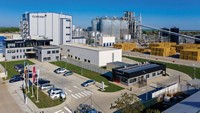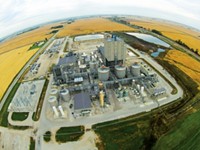Advertisement
Grab your lab coat. Let's get started
Welcome!
Welcome!
Create an account below to get 6 C&EN articles per month, receive newsletters and more - all free.
It seems this is your first time logging in online. Please enter the following information to continue.
As an ACS member you automatically get access to this site. All we need is few more details to create your reading experience.
Not you? Sign in with a different account.
Not you? Sign in with a different account.
ERROR 1
ERROR 1
ERROR 2
ERROR 2
ERROR 2
ERROR 2
ERROR 2
Password and Confirm password must match.
If you have an ACS member number, please enter it here so we can link this account to your membership. (optional)
ERROR 2
ACS values your privacy. By submitting your information, you are gaining access to C&EN and subscribing to our weekly newsletter. We use the information you provide to make your reading experience better, and we will never sell your data to third party members.
Business
Building A New Biofuels Industry
After years of delays, the first commercial-scale cellulosic fuel facilities are nearing completion
by Melody M. Bomgardner
January 28, 2013
| A version of this story appeared in
Volume 91, Issue 4

The cellulosic biofuels industry will arrive at its own launch party several years late. Optimistic forecasts codified in 2007 called for the U.S. to produce 100 million gal of the renewable fuels in 2010. None was made that year, and in 2012 production likely did not top 25,000 gal. But the wait for cellulosic biofuels will soon be over; the first group of commercial-scale facilities will be completed this year.
It may be another five years or more before the fledgling industry catches up to the lofty goals called for in the Renewable Fuel Standard (RFS)—a federal-government-mandated schedule of yearly biofuel production targets. Indeed, the scant output so far has given plenty of ammunition to biofuel critics. Still, most analysts believe that successful start-up of facilities by Poet-DSM Advanced Biofuels, KiOR, Beta Renewables, and other firms will validate the technologies, confirm financial returns, and draw additional investment.
“If you look at these projects, they show that the industry has come a long way,” says Jim Lane, editor and publisher of Biofuels Digest, an online newsletter covering biofuels. He’s not dwelling on past proclamations. “Sure, we could rerun the tape, but there were many things the companies were not in control of. The good news is they are here.”
Cellulosic fuels are intended to be an alternative to petroleum-derived fuels and first-generation biofuels made from corn. The barriers to commercial success have been technology, the ability to scale up, and project financing. By 2008, after five years of laboratory work and pilot successes, several biofuels firms thought their technology was ready to go. But when the recession hit, the capital markets dried up, and the industry spun its wheels.
“What we view as the dominant factor behind the slow scale-up is constrained availability of capital,” asserts Pavel Molchanov, research analyst for investment bank Raymond James in a note to investors. “Second-generation commercialization is a highly capital-intensive undertaking—much more so than the prior decade’s build-out of corn ethanol plants.”
Molchanov says facilities based on technology that uses dense but cheap cellulosic feedstock such as timberland wastes or municipal waste come with the highest price tag. KiOR’s $222 million plant will make 13 million gal per year of its biocrude from forestry residuals. That works out to a capital cost of $17 per gal. Cellulosic ethanol plants that run on corn-farming leftovers, like the facility run by a joint venture of Poet and DSM, will carry capital costs of $10 per gal and up. In contrast, modern ethanol plants that run on corn sugar are built for close to $2.00 per gal.
However, corn ethanol producers face high and volatile feedstock costs, and that is why cellulosic fuel producers are confident that their more expensive plants will still be profitable. “We wouldn’t be making the investment if we didn’t think it was an opportunity to generate good business for the joint venture,” says Wade Robey, a member of the Poet-DSM board. Robey says he is “very bullish” about Project Liberty, the venture’s first facility, located in Iowa, as well as plans to expand to other Poet locations that currently make corn ethanol.
Expanding may bring new hardships, however. For companies that use agricultural waste, Lane points out, each new facility will be increasingly difficult to site because of what he calls the “biomass radius problem.” A typical facility consumes 285,000 tons of biomass per year, requiring a reach of 40 to 50 miles of cropland. The next plant must find its own untouched radius of land.
All the more reason why it’s good to be first. Access to capital is the key reason why Beta Renewables’ plant, in Crescentino, Italy, will likely be the first to start commercial production. Beta’s parent company, Mossi & Ghisolfi, the world’s second-largest producer of polyester resin for bottles, has heavily invested in cellulosic ethanol research and development. Beta’s sister company, Chemtex, M&G’s engineering division, built the plant.
“It was a gutsy decision to invest hundreds of millions of M&G’s own money to be first—to put their money where their mouth is and slash through the chicken-and-egg problem,” says Kevin Gray, vice president of biobased chemicals for Chemtex.
Although the Italian plant will be built without any government assistance, Beta’s first U.S. facility, in Sampson County, N.C., will benefit from a $99 million loan guarantee and a $4 million biomass crop assistance grant from the U.S. Department of Agriculture. Other projects have been similarly blessed. Abengoa can take advantage of a $133 million loan guarantee from the Department of Energy for its cellulosic ethanol plant near Hugoton, Kan. Ineos Bio has been awarded a $50 million DOE grant, a $75 million USDA loan guarantee, and a $2.5 million grant from the state of Florida.
The more important government assistance, however, comes from the Environmental Protection Agency’s RFS, which requires fuel blenders to use cellulosic fuels in their product or pay a fine. By guaranteeing that all production will be bought, RFS drives investment in new capacity.
Petroleum and fuel blenders are pressuring EPA to waive the requirement or even do away with it. “Congress foresaw that the aggressive renewable fuel standards might be unattainable and established several waiver provisions in the Clean Air Act, including for inadequate domestic supply,” Charles T. Drevna, president of the American Fuel & Petrochemical Manufacturers, recently said. “If zero production doesn’t meet the definition of inadequate, then it is time for Congress to reexamine the entire RFS and its failure to produce their desired results.”
So far, challenges to RFS have hit a brick wall at EPA. The agency has not yet set the amount of cellulosic biofuel that blenders must use in 2013, but the Energy Information Administration has told EPA that it expects 9.6 million gal to be produced this year.
In 2014–15, capacity will expand again as the first facilities from BlueFire Renewables, DuPont, Fulcrum BioEnergy, LanzaTech, Mascoma, and ZeaChem come on-line. Not every company is likely to succeed, but the scattershot approach will uncover technologies that work, Lane predicts. “You don’t need more than three if they work,” he says. “If you have a growing technology and you take the corn ethanol boom as an example, there is no reason you can’t build 100 or 200 of these plants a year.”






Join the conversation
Contact the reporter
Submit a Letter to the Editor for publication
Engage with us on Twitter